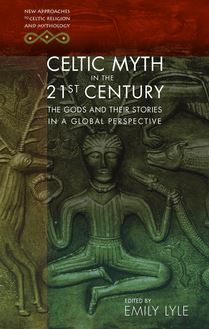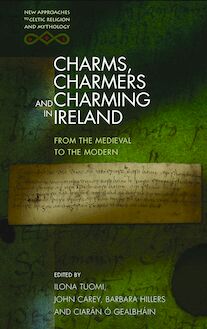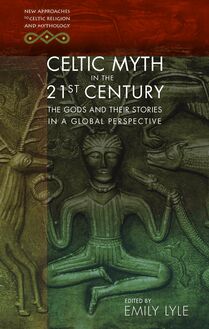Celtic Myth in the 21st Century , livre ebook
129
pages
English
Ebooks
2018
Vous pourrez modifier la taille du texte de cet ouvrage
Obtenez un accès à la bibliothèque pour le consulter en ligne En savoir plus
Découvre YouScribe en t'inscrivant gratuitement
Découvre YouScribe en t'inscrivant gratuitement
129
pages
English
Ebooks
2018
Vous pourrez modifier la taille du texte de cet ouvrage
Obtenez un accès à la bibliothèque pour le consulter en ligne En savoir plus
Publié par
Date de parution
07 février 2018
Nombre de lectures
2
EAN13
9781786832078
Langue
English
Poids de l'ouvrage
2 Mo
This wide-ranging book contains twelve chapters by scholars who explore aspects of the fascinating field of Celtic mythology – from myth and the medieval to comparative mythology, and the new cosmological approach. Examples of the innovative research represented here lead the reader into an exploration of the possible use of hallucinogenic mushrooms in Celtic Ireland, to mental mapping in the interpretation of the Irish legend Táin Bó Cuailgne, and to the integration of established perspectives with broader findings now emerging at the Indo-European level and its potential to open up the whole field of mythology in a new way.
Preface
Acknowledgements
List of Illustrations
List of Abbreviations
List of Contributors
Introduction: Celtic Mythology in the 21st Century
Jonathan Wooding, Series Editor
Section 1: Myth and the Medieval
1. God and Gods in the Seventh Century: Tírechán on St Patrick and King Lóegaire’s Daughters - Elizabeth A. Gray
2. Time, Identity and the Otherworld: A Note on The Wooing of Étaín - John Carey
3. The Celtic Dragon Myth Revisited - Joseph F. Nagy
4. Tory Island and Mount Errigal: Landscape Surrogates in Donegal for the Gods Balor and Lug - Brian Lacey
Section 2: Comparative Mythology
5. Ireland as Mesocosm - Grigory Bondarenko
6. Hunting the Deer in Celtic and Indo-European Mythological Contexts - Maxim Fomin
7. Gods, Poets and Entheogens: Ingesting Wisdom in Early Irish Literary Sources - Sharon Paice MacLeod
8. The Armorican Voyage to the Afterlife and Celtic Myths - Fañch Bihan-Gallic
Section 3: The New Cosmological Approach
9. Towards Adopting a Double Perspective on Celtic Mythology and its Prehistoric Roots - Emily Lyle
10. Sisters’ Sons in the Fourth Branch of the Mabinogi - Anna June Pagé
11. Fashioners of the Cosmos in Ireland and India: The Dagda and Tvastr - John Shaw
12. Psycho-Cosmology: Mental Mapping in Táin Bó Cuailgne - James Carney
Bibliography
Index
Publié par
Date de parution
07 février 2018
Nombre de lectures
2
EAN13
9781786832078
Langue
English
Poids de l'ouvrage
2 Mo
New Approaches
to Celtic Religion
and Mythology
CELTIC MYTH
IN THE
21 ST CENTURY
NEW APPROACHES
TO CELTIC RELIGION AND MYTHOLOGY
Series Editor
Jonathan Wooding, University of Sydney
Editorial Board
Jacqueline Borsje, University of Amsterdam
John Carey, University College Cork
Joseph F. Nagy, University of California, Los Angeles
Thomas O Loughlin, University of Nottingham
Katja Ritari, University of Helsinki
New Approaches
to Celtic Religion
and Mythology
CELTIC MYTH
IN THE
21 ST CENTURY
THE GODS AND THEIR STORIES
IN A GLOBAL PERSPECTIVE
EDITED BY
EMILY LYLE -->
UNIVERSITY OF WALES PRESS 2018
© The Contributors, 2018
All rights reserved. No part of this book may be reproduced in any material form (including photocopying or storing it in any medium by electronic means and whether or not transiently or incidentally to some other use of this publication) without the written permission of the copyright owner. Applications for the copyright owner s written permission to reproduce any part of this publication should be addressed to the University of Wales Press, 10 Columbus Walk, Brigantine Place, Cardiff CF10 4UP.
www.uwp.co.uk
British Library CIP Data
A catalogue record for this book is available from the British Library.
ISBN: 978-1-78683-205-4
e-ISBN: 978-1-78683-207-8
The right of the Contributors to be identified as authors of this work has been asserted in accordance with sections 77 and 79 of the Copyright, Designs and Patents Act 1988.
The publisher has no responsibility for the persistence or accuracy of URLs for any external or third-party internet websites referred to in this book, and does not guarantee that any content on such websites is, or will remain, accurate or appropriate.
Cover image: Cernunnos, the Celtic horned god. Detail from the Gundestrup Cauldron, c.100 BCE (Heritage Image Partnership Ltd/Alamy).
Cover design: Olwen Fowler.
CONTENTS
Preface
List of Illustrations
List of Abbreviations
List of Contributors
Introduction: Celtic Myth in the 21st Century
Jonathan M. Wooding, Series Editor
SECTION 1: MYTH AND THE MEDIEVAL
1 God and Gods in the Seventh Century: Tírechán on St Patrick and King Lóegaire s Daughters
Elizabeth Gray
2 Identity, Time and the Otherworld: An Observation on The Wooing Of Étaín
John Carey
3 The Celtic Dragon Myth Revisited
Joseph Falaky Nagy
4 Tory Island and Mount Errigal: Landscape Surrogates in Donegal for the Gods Balor and Lug
Brian Lacey
SECTION 2: COMPARATIVE MYTHOLOGY
5 Ireland as Mesocosm
Grigory Bondarenko
6 Hunting the Deer in Celtic and Indo-European Mythological Contexts
Maxim Fomin
7 Gods, Poets and Entheogens: Ingesting Wisdom in Early Irish Literary Sources
Sharon Paice MacLeod
8 The Armorican Voyage to the Afterlife and Celtic Myths
Fañch Bihan-Gallic
SECTION 3: THE NEW COSMOLOGICAL APPROACH
9 Towards Adopting a Double Perspective on Celtic Mythology and its Prehistoric Roots
Emily Lyle
10 Sisters Sons in the Fourth Branch of the Mabinogi
Anna June Pagé
11 Fashioner Gods in Ireland and India: the Dagda and Tvaṣṭṛ
John Shaw
12 Psycho-Cosmology: Mental Mapping in Táin Bó Cuailnge
James Carney
Bibliography
PREFACE
T his publication stems from an initiative at the University of Edinburgh begun when Professor Rob Dunbar became head of the department of Celtic and Scottish Studies in 2013. At that time, he encouraged the holding of a colloquium on Thinking about Celtic Mythology in the 21st Century , with a board consisting of Professor Dunbar, Professor Wilson McLeod, Dr John Shaw and myself. The first colloquium was small but stimulating, and led to the holding of further colloquia on the same topic in 2014 and 2015. All the contributors to this volume, except Brian Lacey, attended one or more of these gatherings.
When a call for contributions to this proposed publication was circulated, an advisory board was established, consisting of John Carey, Rob Dunbar, Elizabeth Gray, Barbara Hillers, John Koch, Wilson McLeod, Daniel Melia, Joseph Nagy, John Shaw and Jonathan Wooding, and I am grateful to all these scholars for their careful work. I am especially indebted to Elizabeth Gray, who advised on all the contributions, and to Wilson McLeod, who kindly undertook the burden of final preparation.
Happily, the University of Edinburgh initiative coincided with the establishment of the University of Wales Press series entitled New Approaches to Celtic Religion and Mythology , under the editorship of Jonathan Wooding, and this book seemed to find its natural place in that development. I should like to thank the members of the Press for their friendly help in the process of bringing the book to publication.
Emily Lyle, Editor
LIST OF ILLUSTRATIONS
FIGURE 4.1
Cloch Cenn Fáelaid - the stone of Cenn Fáelad, Falcarragh, Co. Donegal
FIGURE 6.1
Cernunnos, the antlered Celtic divinity, second century AD
FIGURE 6.2
Stag God, Grandfontaine, Donon, third century AD
FIGURE 9.1
The spatio-temporal structure of the Lyle 3-axis cosmological model
FIGURE 12.1
The spatio-temporal structure of the Genesis narrative
TABLE 12.1
The eight semantic locations in the Táin
LIST OF ABBREVIATIONS
ATU
Aarne-Thompson-Uther
BB
Book of Ballymote
(e)DIL
(Electronic) Dictionary of the Irish Language
LL
Lebor Laignech
RIA
Royal Irish Academy
SDD
Suidigud Tellaig Temra
TBF
Táin Bó Fraích
TCD
Trinity College Dublin
TDG
Tóruigheacht Dhiarmada agus Ghráinne
YBL
Yellow Book of Lecan
LIST OF CONTRIBUTORS
Fañch Bihan-Gallic is a doctoral student in Gaelic Studies at the University of Aberdeen.
Grigory Bondarenko is a General Director of LRC Publishing House, Moscow, and is the author of Studies in Irish Mythology .
John Carey is Professor of Early and Medieval Irish at University College Cork.
James Carney is Senior Research Associate in Psychology at Lancaster University.
Maxim Fomin is Senior Lecturer in Celtic at Ulster University.
Elizabeth Gray is an Associate of the Department of Celtic Languages and Literatures at Harvard University, having previously held posts there as Assistant and Associate Professor.
Brian Lacey , a former lecturer at Ulster University, was Director of the Discovery Programme for advanced research in Irish archaeology from 1998 to 2012.
Emily Lyle is an Honorary Fellow in the Department of Celtic and Scottish Studies at the University of Edinburgh.
Joseph Falaky Nagy is the Henry L. Shattuck Professor of Irish Studies at Harvard University and Professor Emeritus of Celtic and Folklore at the University of California, Los Angeles.
Anna June Pagé is a Lecturer in the Institut für Sprachwissenschaft at the University of Vienna.
Sharon Paice MacLeod is the author of Celtic Myth and Religion: A Study of Traditional Belief and Director of the Eólas ar Senchais research project, funded by the Canada Council for the Arts.
John Shaw served as Senior Lecturer in Scottish Ethnology in the Department of Celtic and Scottish Studies, University of Edinburgh, where he is currently an Honorary Fellow.
Jonathan M. Wooding is Professor of Celtic Studies at the University of Sydney.
INTRODUCTION: CELTIC MYTH IN THE 21ST CENTURY
Jonathan M. Wooding, Series Editor
C eltic Studies is a field long connected with the study of mythology. In the western European context the Celtic-speaking peoples have been amongst those most often held up as the inheritors of a rich body of tradition . From early descriptions of the Gauls through to modern accounts of Scottish Highland culture we find a recurrent emphasis on oral culture and a concern with the supernatural in daily life. In modern scholarship Celtic languages developed a strong connection to the discipline of comparative Indo-European philology and, in turn, to theories of comparative mythology that are its by-products. Aside from these external perspectives, a primary stimulus of interest for mythologists is the very strong sense of the mythic present within Celtic literature itself; reference to deities, to heroes with supernatural qualities, and to events of the distant past. For these reasons, studies of Celtic religion, folklore and literature have very often been made subject to mythological models of interpretation.
In the twenty-first century we are more than ever mindful that conceptions and associations of the Celtic may be socially and politically constructed, as well as historically situated. 1 Past claims for the particular relevance of mythology to Celtic Studies proceeded from assumptions concerning remoteness and conservatism of tradition that are now reasonably open to question. 2 We are presented with many contrasting perspectives. Though remote in European political geography, Celtic-speaking peoples were also innovative, being amongst the earliest to adopt literacy in the vernacular. In the early twentieth century one scholar could travel to the Great Blasket Island with the aim of stimulating a new genre of folk-literature; another would leave convinced that he had collected especially conservative oral traditions. 3 We have become ever more conscious of the role of the author in creating, as well as communicating a sense of the mythic. In the mid-twentieth century, medievalists were prepared to rewrite literary narratives to fit the underlying myths they detected in them. By the 1990s, when such approaches had come to be rejected as representing a distorting nativism , these texts were often read anew as Christian allegories rather than fragments of a decayed mythology.
In the twenty-first century, then, we look back on a range of often sharply contrasting positions with respect to mythology and tradition. How do we move forward from these in a productive fashion? We should be conscious that the last century was, in varying degree, a decolonising period in Celtic cultures, in which process tradition became a politically charg






